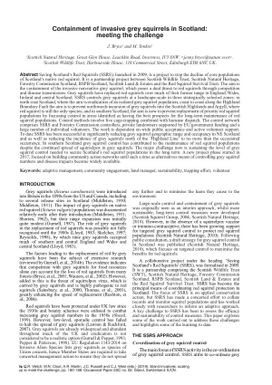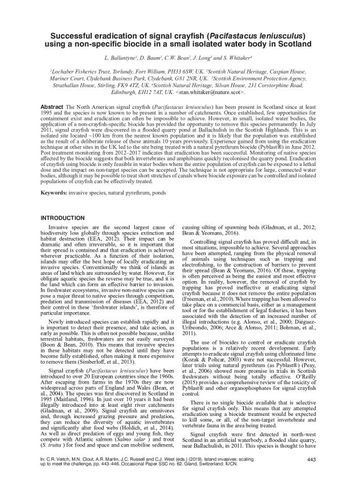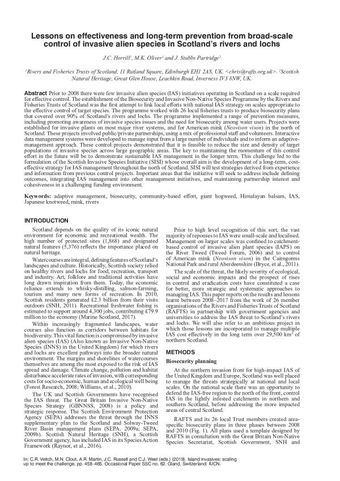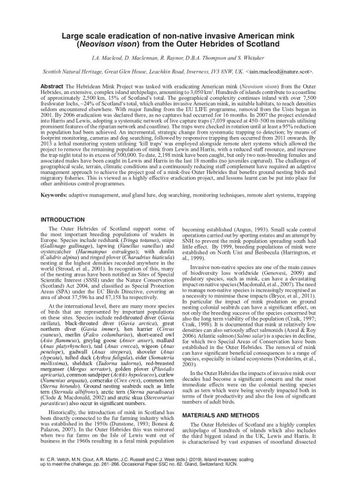Containment of invasive grey squirrels in Scotland: meeting the challenge
- Description:
- Saving Scotlands Red Squirrels (SSRS), launched in 2009, is a project to stop the decline of core populations of Scotlands native red squirrel. It is a partnership project between Scottish Wildlife Trust, Scottish Natural Heritage, Forestry Commission Scotland, RSPB Scotland, Scottish Land & Estates and the Red Squirrel Survival Trust. The aim is the containment of the invasive non-native grey squirrel, which poses a dual threat to red squirrels through competition and disease transmission. Grey squirrels have replaced red squirrels over much of their former range in England, Wales, Ireland and central Scotland. SSRS controls grey squirrels at a landscape-scale in three strategically selected zones: in north-east Scotland, where the aim is eradication of an isolated grey squirrel population; coast to coast along the Highland Boundary Fault the aim is to prevent northwards incursion of grey squirrels into the Scottish Highlands and Argyll, where red squirrel is still the only species; and in southern Scotland, the aim is now to prevent replacement of priority red squirrel populations by focussing control in areas identifi ed as having the best prospects for the long-term maintenance of red squirrel populations. Control methods involve live cage-trapping combined with humane dispatch. The control network comprises SSRS and Forestry Commission controllers, private landowners supported by EU/government funding and a large number of individual volunteers. The work is dependent on wide public acceptance and active volunteer support. To date SSRS has been successful at signifi cantly reducing grey squirrel geographic range and occupancy in NE Scotland and as well as reducing the incidence of grey squirrels north of the Highland Line to no more than the occasional occurrence. In southern Scotland grey squirrel control has contributed to the maintenance of red squirrel populations despite the continued spread of squirrelpox in grey squirrels. The major challenge now is sustaining the level of grey squirrel control needed to secure Scotlands red squirrel populations in the long term. A new project phase started in 2017, focused on building community action networks until such a time as alternatives means of controlling grey squirrel numbers and disease impacts become widely available.
- Display date:
- 2019
- Location:
- Pacific Region
- Collections:
- Secretariat of the Pacific Regional Environment Programme (SPREP)
- Publisher:
- Secretariat of the Pacific Regional Environment Programme (SPREP)
- Content partner:
- Secretariat of the Pacific Regional Environment Programme (SPREP)
- Availability:
- Not specified
-
Copyright status: All rights reservedFind out more about what you are able to do with this itemThis item is all rights reserved, with means you'll have to get permission from Secretariat of the Pacific Regional Environment Programme (SPREP) before using it. For more information, please see our use and reuse page.What can I do with this item?Non-infringing useNZ copyright law does not prevent every use of a copyright work, and this item may be hosted by an international institute or organisation. You should consider what you can and cannot do with a copyright work.No sharingYou may not copy and/or share this item with others without further permission. This includes posting it on your blog, using it in a presentation, or any other public use.No modifyingYou are not allowed to adapt or remix this item into any other works.No commercial useYou may not use this item commercially.
Related items
Welcome and warm Pasifik greetings
The information on this site has been gathered from our content partners.
The names, terms, and labels that we present on the site may contain images or voices of deceased persons and may also reflect the bias, norms, and perspective of the period of time in which they were created. We accept that these may not be appropriate today.
If you have any concerns or questions about an item, please contact us.



